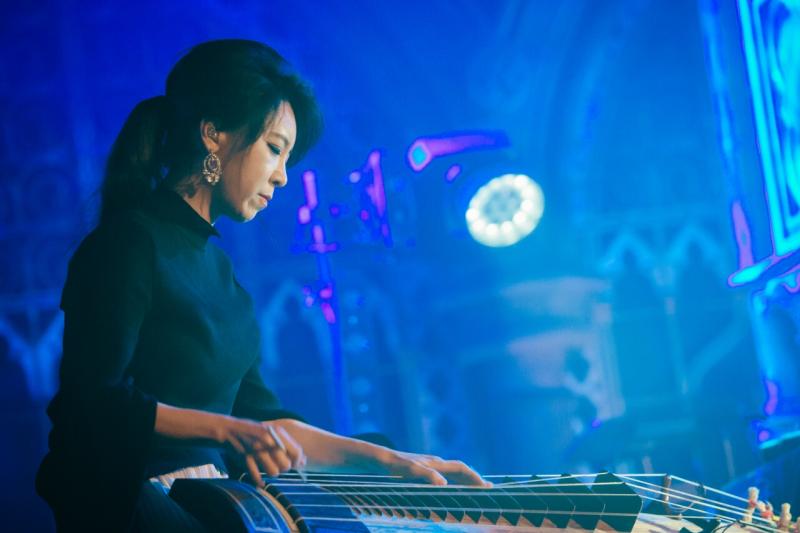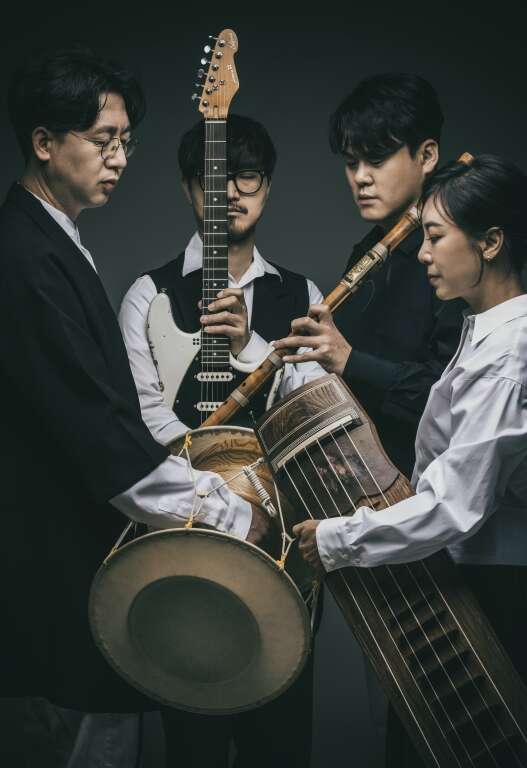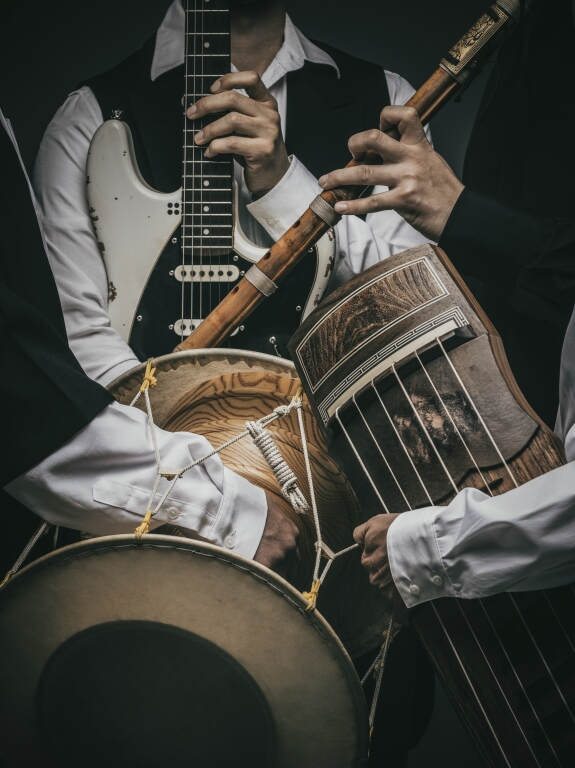10 Questions for Black String’s Youn Jeong Heo | reviews, news & interviews
10 Questions for Black String’s Youn Jeong Heo
10 Questions for Black String’s Youn Jeong Heo
K-Music special: The founder of Korea’s finest quartet discusses their intense and otherworldly music

The first K-Music festival landed in London for than a decade ago, and has brought an eclectic range of bands and musicians from Korea to the stages of the capital, whether that’s the sorrowful storytelling tradition of Pansori, the sonic attack of bands like Jambinai or Black String, who return this year to King’s Place on 30 October, with the extraordinary sound of the gayageum – part harp, part oud, part theramin – under the hands of band leader Youn Jeong Heo.
This year’s festival opens tonight at the Barbican with Lear from the National Changgeuk Company. Changgeu is a form of Korean opera, and its premiere of one of Shakespeare’s greatest and darkest tragedies is a major restaging and ambitious opener for K-Music 2024.
It’s not all darkness and tragedy, however. The spotlight falls on a range of Korea’s leading female artists and singers. Jazz singer, Youn Sun Nah presents her 12th album in a 30-year career, Elles, a tribute to artists like Nina Simone to Roberta Flack, via Björk and Edith Piaf, joined by pianist Bojan Z at the Union Chapel on 6 October. Soprano Hera Hyesang Park make her K-Music debut with a concert of traditional Korean songs at St John’s Smith Square on 26 October, with pianist Bretton Brown and tenor David Junghoon Kim. And with two K-Music gigs also part of the London Jazz Festival, Lee Il-woo of post-rock noise merchants Jambinai leads No-Noise through uncharted sonic territory, and Heemoon Lee, of SsingSsing, returns to the South Bank with a new band, Obangsingwa.
 But it’s Youn Jeong Heo of legendary Black String (pictured) who features here in our 10 Questions feature. She and the band will be previewing new music from their forthcoming album, alongside pieces from their albums Mask Dance (2016) and Karma (2019), and here discusses her musical origins, inspirations and new directions, the secrets of the geomungo, the use of drones, and celebrating Black String’s 10th year.
But it’s Youn Jeong Heo of legendary Black String (pictured) who features here in our 10 Questions feature. She and the band will be previewing new music from their forthcoming album, alongside pieces from their albums Mask Dance (2016) and Karma (2019), and here discusses her musical origins, inspirations and new directions, the secrets of the geomungo, the use of drones, and celebrating Black String’s 10th year.
Tim Cumming: Yoon Jeong Heo, what was your background, musical training, and how did you come to start Black String, and what was your intention and purpose?
Youn Jeong Heo: I was first introduced to Korean traditional music while learning Korean traditional dance at a young age. My father, a pioneer in Korea’s theater scene, had a profound influence on me. At his suggestion, I enrolled at Guggak National High School, where I was introduced to the geomungo. This marked the beginning of my journey to explore the roots of Korean music. I had the privilege of studying geomungo sanjo under Gap-deok Han, a master recognised as a Human Cultural Asset.
Black String was formed at the suggestion of producer Myung-guk Kye, who was overseeing the Korea-UK cultural exchange program. Initially, the band consisted of both Korean and British musicians, and we had our debut performance in London. After returning to Korea, I aimed to establish an innovative ensemble centered around the geomungo, leading to the current lineup of four members.
TC: Tell me about the geomungo, its origin and history and sound capabilities, and how you now use it in Black String?
YJH: The geomungo, a traditional Korean string instrument dating back to the Goguryeo period, boasts a broad range of octaves, from deep resonant tones to bright high notes. It is featured in the murals of the Goguryeo tombs, which depict musicians playing the geomungo alongside dancers and singers, underscoring its significance in Goguryeo music. In Black String, the geomungo provides the foundation, establishing the bass, melody, and rhythm of our music.
Traditionally, the geomungo has been viewed as a masculine instrument, often performed by male musicians playing slow, introspective pieces. However, through Black String, I strive to showcase its dynamic and versatile potential, presenting a powerful performance style as a female artist.
TC: How did you develop and evolve the band sound, combining the geomungo with the guitar and electronics of Jean Oh, and the vocals/percussion of Min Wang Hwang?
YJH: Jean Oh brings abstract sounds with the guitar, creating a new sonic space for the geomungo to blend and adapt. Electronic music is also integral to evolving our sound. We love pushing boundaries, merging ancient analogue tones with contemporary digital elements. Our vocalist delivers intense, powerful performances that marry traditional styles with futuristic sounds, while our percussionist seeks a balance between the old and the new by incorporating and modifying complex Korean rhythms.
TC: What are the key qualities in the other traditional instruments you use – daegeum and sogeum flute and yanggeum hammered dulcimer – played by Aram Lee?
YJH: The daegeum, a traditional Korean bamboo flute played since the Silla period [668–935CE], adds vitality and richness to our sound. Its voice-like tone infuses warmth into our pieces, brought to life by Aram’s performance. In “Hanging Gardens of Babylon” from our second album, the yanggeum, a struck zither, lends an exotic, Middle Eastern flavor to our music, making the track one of the most epic in our repertoire.
TC: How does Black String fit in with Koran folk and folkloric traditions, and with the contemporary music culture in Korea?
YJH: Black String’s music is rooted in traditional Korean music, yet we continuously seek to expand our means of expression. Our album features tracks like “Seven Beats,” based on the traditional Korean rhythm chilchae, and “Song From Heaven,” a reinterpretation of a Jindo shamanic song. “Strangeness Moon,” inspired by Munmyo Ritual Music, evokes an otherworldly atmosphere. While we delve deeply into the essence of Korean traditional music, we also aim to create new pathways for Korean band music through experimental approaches. Our improvisational and experimental elements align with jazz, but we prefer to describe Black String’s music as “free music that transcends boundaries”.
 TC: Drones are big in British and Irish contemporary folk music with bands like Lankum and young Scottish piper Brìghde Chaimbeul – what’s your band philosophy and practice behind the use of drones on colossal tracks like “Surena”?
TC: Drones are big in British and Irish contemporary folk music with bands like Lankum and young Scottish piper Brìghde Chaimbeul – what’s your band philosophy and practice behind the use of drones on colossal tracks like “Surena”?
YJH: The geomungo’s three strings, playing the same note, are essential to its structure serving as a drone, similar to Indian music's use of drones. This principle is central to our music as well; the drone created by the geomungo is often replaced and transformed by the daegeum, guitar, and percussion (pictured left), providing a stable foundation over which complex melodies and rhythms are built.
Traditional Korean instruments typically don't rely on harmonic structures but instead create music through intricate melodies and complex rhythms, each blending with the unique timbres of various instruments. In this context, the drone provides a consistent foundation, supporting the diversity of our sound and anchoring it with a sense of stability.
TC: When I saw you at Grand Junction in 2021, French-Vietnamese Nguyen Le guested, brilliantly. Are there more collaborations with him, or other musicians?
YJH: We have collaborated with numerous musicians, including Nguyên Lê (guitar) and many international artists like Stephan Mikus (wind instrument), Arun Ghosh (clarinet), Idan Rachel (vocals), Vincent Peirani (accordion), Mathias Eick (trumpet), Tetsu Sai-to (bass), Mark Dresser (bass), Michael Desen (trombone), Anthony Davis (composer), Susie Ibarra (percussion), and Tim Galand (saxophone).
TC: What new music and sounds are you bringing to the UK and to King’s Place for 2024’s K-Music?
YJH: We are currently preparing our third album, set for release in 2025. This album, tentatively titled Road of Oasis, will mark our 10th anniversary and reflect the diverse sounds of the geomungo, daegeum, percussion, and guitar, celebrating the unique musical identities of each member. It will present a vibrant array of styles, blending jazz, rock, and world music, reflecting our musical journey over the past decade while envisioning the path we hope to take in the next 10 years.
TC: What are your inspirations, musically and sonically and philosophically and when will you be releasing a new album with ACT, and what kind of music will be on it?
YJH: My inspirations are deeply rooted in the natural beauty and traditional culture of Korea, as well as the artistry of traditional music masters, jazz virtuosos, and world musicians. I am also influenced by visual arts such as beautiful and creative paintings, architecture, literature that embodies the thoughts of great artists, and captivating films.
We are currently working on our third album, set for release in 2025. This album will mark a departure from our previous work. In development since 2021, this album commemorates Black String’s 10th anniversary, encapsulating our musical journey over the past decade. It captures our experiences of engaging with different musical traditions and local musicians from around the world, symbolizing a musical Silk Road that bridges East and West, North and South.
“Road of Oasis” is a contemporary reinterpretation of the Gyeonggido Dang-gut, infusing metal elements into the primal sounds of shamanic music, inviting listeners to experience a unique sense of ecstasy. Another track, “Waves of Fire,” powerfully conveys the poignant melody of Menari [ a traditional work song sung by farmers while they weed the fields] while contrasting fire and water through chromatic movement and rapid 4/4 rhythms, evoking vivid imagery of fierce flames and towering waves.
TC: What’s the loudest thing you’ve ever heard (or played…)?
YJH: Metal music, electronic music.
- The K-Music festival launches tonight at the Barbican and runs through to 23 November, with Black String playing King's Place on 30 October.
- More new music reviews on theartsdesk
- Tim Cumming's website
Buy
Explore topics
Share this article
The future of Arts Journalism
You can stop theartsdesk.com closing!
We urgently need financing to survive. Our fundraising drive has thus far raised £49,000 but we need to reach £100,000 or we will be forced to close. Please contribute here: https://gofund.me/c3f6033d
And if you can forward this information to anyone who might assist, we’d be grateful.

Subscribe to theartsdesk.com
Thank you for continuing to read our work on theartsdesk.com. For unlimited access to every article in its entirety, including our archive of more than 15,000 pieces, we're asking for £5 per month or £40 per year. We feel it's a very good deal, and hope you do too.
To take a subscription now simply click here.
And if you're looking for that extra gift for a friend or family member, why not treat them to a theartsdesk.com gift subscription?
more New music
 'Vicious Delicious' is a tasty, burlesque-rockin' debut from pop hellion Luvcat
Contagious yarns of lust and nightlife adventure from new pop minx
'Vicious Delicious' is a tasty, burlesque-rockin' debut from pop hellion Luvcat
Contagious yarns of lust and nightlife adventure from new pop minx
 Music Reissues Weekly: Hawkwind - Hall of the Mountain Grill
Exhaustive box set dedicated to the album which moved forward from the ‘Space Ritual’ era
Music Reissues Weekly: Hawkwind - Hall of the Mountain Grill
Exhaustive box set dedicated to the album which moved forward from the ‘Space Ritual’ era
 'Everybody Scream': Florence + The Machine's brooding sixth album
Hauntingly beautiful, this is a sombre slow burn, shifting steadily through gradients
'Everybody Scream': Florence + The Machine's brooding sixth album
Hauntingly beautiful, this is a sombre slow burn, shifting steadily through gradients
 Cat Burns finds 'How to Be Human' but maybe not her own sound
A charming and distinctive voice stifled by generic production
Cat Burns finds 'How to Be Human' but maybe not her own sound
A charming and distinctive voice stifled by generic production
 Todd Rundgren, London Palladium review - bold, soul-inclined makeover charms and enthrals
The wizard confirms why he is a true star
Todd Rundgren, London Palladium review - bold, soul-inclined makeover charms and enthrals
The wizard confirms why he is a true star
 It’s back to the beginning for the latest Dylan Bootleg
Eight CDs encompass Dylan’s earliest recordings up to his first major-league concert
It’s back to the beginning for the latest Dylan Bootleg
Eight CDs encompass Dylan’s earliest recordings up to his first major-league concert
 Ireland's Hilary Woods casts a hypnotic spell with 'Night CRIÚ'
The former bassist of the grunge-leaning trio JJ72 embraces the spectral
Ireland's Hilary Woods casts a hypnotic spell with 'Night CRIÚ'
The former bassist of the grunge-leaning trio JJ72 embraces the spectral
 Lily Allen's 'West End Girl' offers a bloody, broken view into the wreckage of her marriage
Singer's return after seven years away from music is autofiction in the brutally raw
Lily Allen's 'West End Girl' offers a bloody, broken view into the wreckage of her marriage
Singer's return after seven years away from music is autofiction in the brutally raw
 Music Reissues Weekly: Joe Meek - A Curious Mind
How the maverick Sixties producer’s preoccupations influenced his creations
Music Reissues Weekly: Joe Meek - A Curious Mind
How the maverick Sixties producer’s preoccupations influenced his creations
 Pop Will Eat Itself, O2 Institute, Birmingham review - Poppies are back on patrol
PWEI hit home turf and blow the place up
Pop Will Eat Itself, O2 Institute, Birmingham review - Poppies are back on patrol
PWEI hit home turf and blow the place up
 'Fevereaten' sees gothic punk-metallers Witch Fever revel in atmospheric paganist raging
Second album from heavy-riffing quartet expands sonically on their debut
'Fevereaten' sees gothic punk-metallers Witch Fever revel in atmospheric paganist raging
Second album from heavy-riffing quartet expands sonically on their debut
 theartsdesk Q&A: Soft Cell
Upon the untimely passing of Dave Ball we revisit our September 2018 Soft Cell interview
theartsdesk Q&A: Soft Cell
Upon the untimely passing of Dave Ball we revisit our September 2018 Soft Cell interview

Add comment